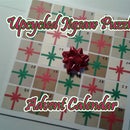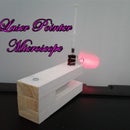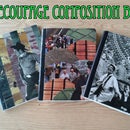Introduction: The Organ Donor Project Part 1: the Recyclone Rotary Combo Amp
I recently butchered a Hammond Aurora 8200 for spare parts and got quite a haul. One of the goodies from the organ was a Leslie rotary speaker. The Leslie is a speaker with a motorized cone that rotates above it to create a unique tremolo effect. It was initially used by organists but was soon adopted by guitarists and harmonica players to add a spatial depth to their sound.
For this project I want to build a prototype stand alone Leslie combo amp. I will use a small Guitar Research practice amp as the main driver for the rotary speaker. The cabinet will be built from recycled materials.
Step 1: The Leslie Rotary Speaker
The Leslie is built onto a 15"x17.5" piece of particle board. The speaker is baffled with a dense foam shell and fiber batting to insure that the sound comes predominantly from the front. The front of the speaker has a frame holding a dense foam cone. This cone is mounted on bearings with a large pulley. This pulley is driven by two motors mounted on the side of the board. One motor is for the fast speed and the other is for the slow speed and only one is switched at a time. The Leslie has six wires- two for the speaker and two sets of power and ground wires for the two motors. The motors take standard mains power and the speaker is 8ohms.
Step 2: Designing the Cabinet
This is not meant to be a beautiful piece of cabinetry. This is a prototype made from recycled and on-hand items.
Since the speaker is baffled in the back this is the easiest cabinet to build. There is no need to consider resonance or bass reflex or any other audiophile mumbo-jumbo- just build a box to protect the speaker unit. Since the Leslie is built on a 15"x17.5" board I made that my inside dimensions. I measured the baffle shell and the front cone and support frame and found that I needed about four inches in the back and eight inches up front. I decided on a total dimension of 16.25"x18.75"x12" to accommodate the thickness of my material. The idea was to create a box around the Leslie unit with a solid top, bottom and front and partial sides with large openings to pass the sound.
I recently took apart a cheap flat pack dresser. The leftover laminated particle board pieces were still out on the carport so I decided to use them for the prototype cabinet. My final cut list was-
1-15"x12" top panel
1-15"x12" bottom panel
2-4"x18.75" rear side panels
2-2"x18.75" front side panel
1-15"x17.5" front panel
1-16"x18.5" rear cover (pasteboard)
Everything was cut down on the table saw and assembled with recycled screws from the original dresser. I built the cabinet around the board the Leslie was mounted to. Take a look at the pics for assembly details. This basic design could be done in hardwood and stained and sealed or it can be made from plywood and covered in a classic tweed, faux leather or whatever you want.
Step 3: The Amp
When I tested the Leslie I used this small Guitar Research practice amp to drive the Leslie speaker. The amp sounded way batter than it did with its original speaker. I decided to incorporate it into my design. I partially disassembled the amp to remove the chassis. This is the part with the knobs and plugs on it. On the inside all the necessary parts of the amplifier are mounted to this bent steel plate.Since it was really scratched and rusty, I decided to take it apart and paint it. When the chassis plate was empty I determined how I would mount it to the amp and where I would add new components.
The chassis is a piece of steel plate bent at a right angle. One face has the input plug, the volume knob, the pitch controls and the overdrive switch. The power switch, auxiliary input and headphones out plug were on the other face. Since I determined that I wanted to use that face to mount the chassis in the amp I needed to mark and drill a few more holes on the other side. I needed a hole for the auxiliary input plug but I decided to omit the headphones jack since it wouldn't have the Leslie effect. The original power switch was square. Since making square holes in steel is a pain in the but I just replaced it with a heavy duty toggle switch. I also needed to add a two way switch for the Leslie motor. I marked out the new positions and drilled them out.
I gave the plate a good sanding and primed it with zinc chromate primer. I followed the primer with a coat of light gray folled by Rustoleum silver glitter paint and clear coat on top.When the paint was dry I mounted it in the cabinet. Before I could reinstall the amp components I needed to wire up the Leslie switch. The pics and diagram above explain that better than words could. I also replaced the original square amp power switch with a round shaft toggle switch. When that was done I reinstalled the amp components and the new switches on the chassis and spliced the amp output to the Leslie's speaker wires.
Step 4: Getting Wired
The final step was to tie all the power together. I tied the positive wires from the power cord, the amp and the Leslie together with a wire nut and did the same for the common grounds. I spliced the ground wire from the power cord to the amp chassis and replaced the front panel on the amp. That's it- now it's time to grab a guitar.
Step 5: Presenting the Recyclone Rotary Combo Amp
There's a video here-
I love how this amp sounds! I'm already looking for a new donor organ for MkII.
For the next unit I will make a few improvements. I'll use nice plywood and either paint it or cover it in material. I will also design it so that the top overlaps the sides instead of the way it is now. I'll add grille cloth and I'll make the sides a solid piece with cut out holes rather then have the whole side open like it is. This will add a little protection to the cone and motors. For the next version I'll use the amp and power supply from the organ. Unfortuately I fried the power supply from this one trying to figure out the pinouts. I'd also like to incorporate the spring reverb into the next unit. Stay tuned- more awesome is coming!

Second Prize in the
DIY Audio and Music Contest

Participated in the
On a Budget Contest











